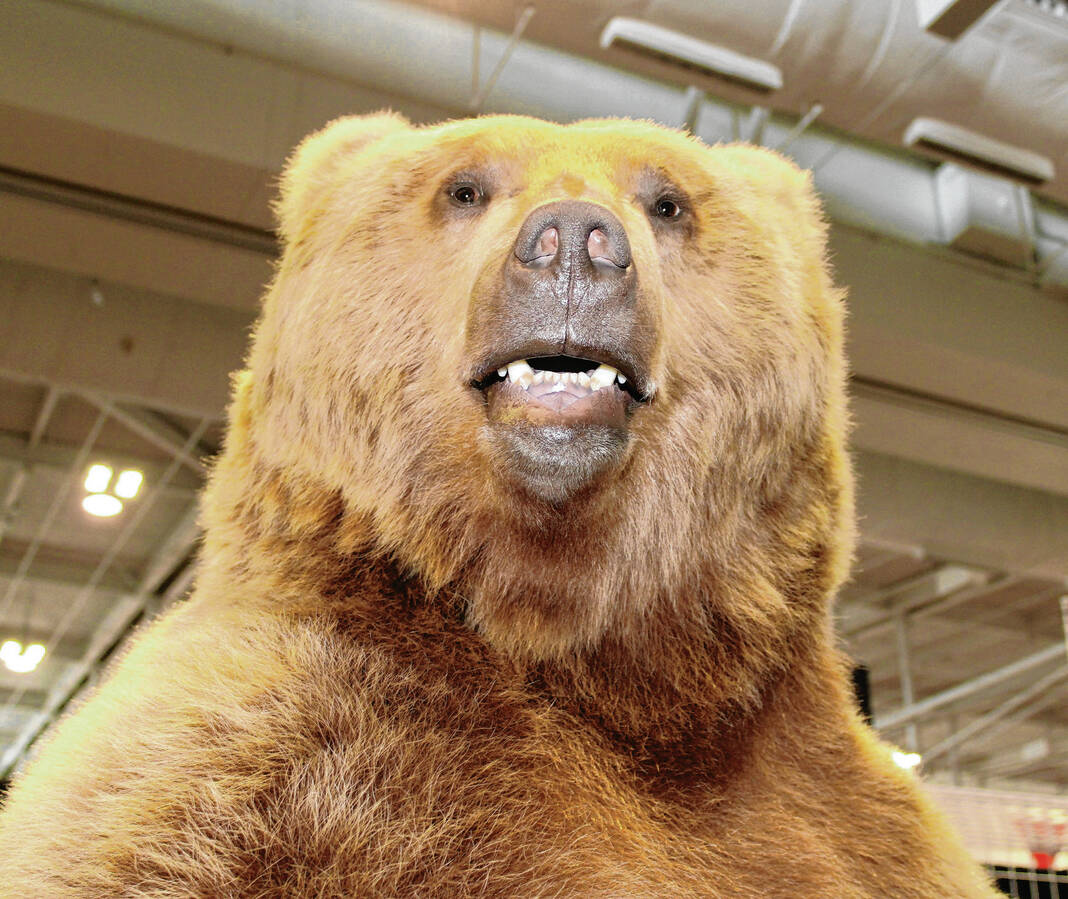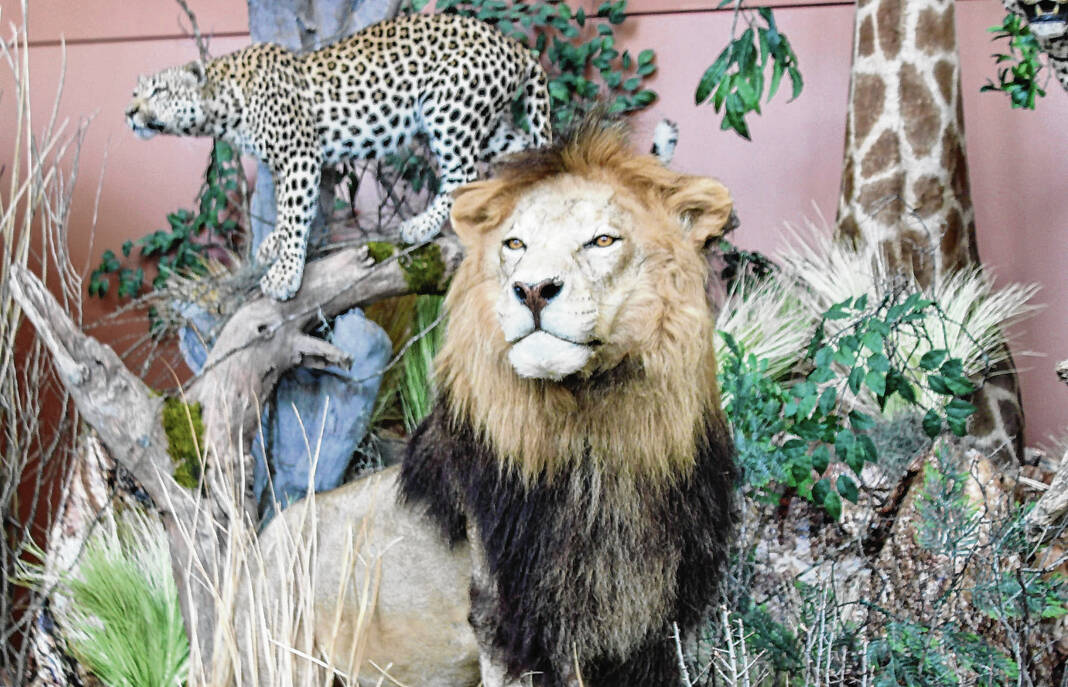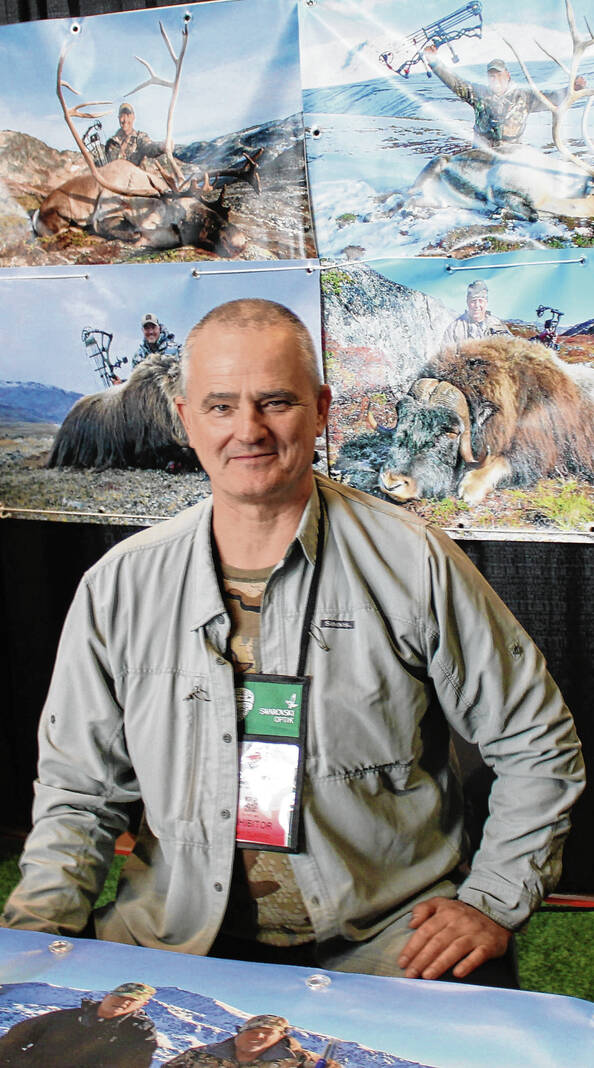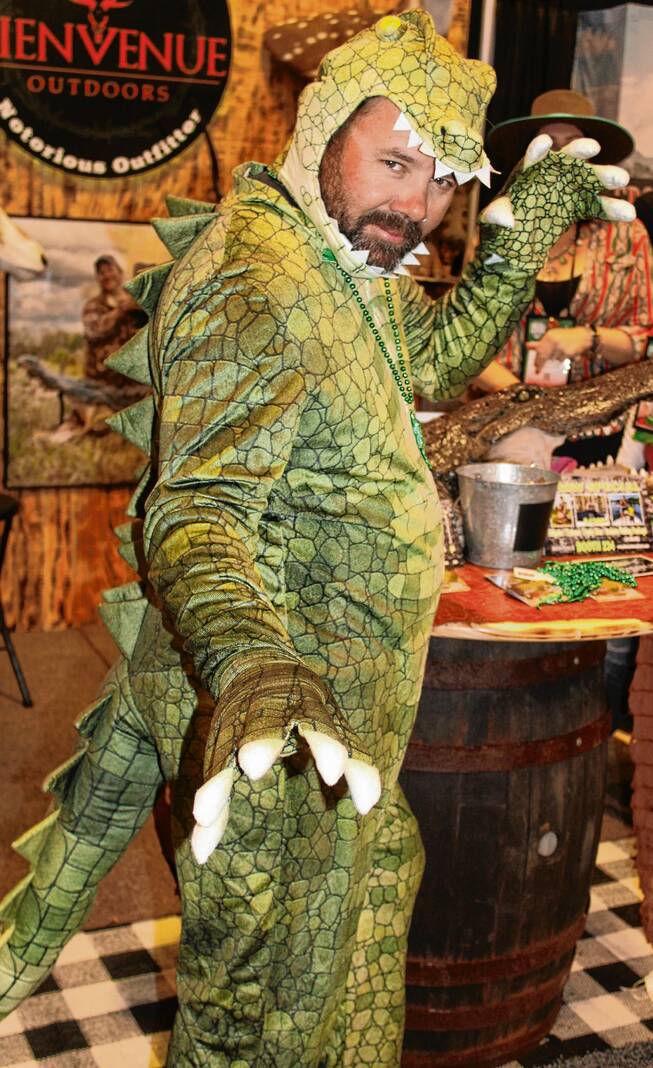
Many vendors sought to jazz up their booths with impressive taxidermy mounts such as this 11-foot brown bear.
Lew Freedman | The Tribune

Safari Club International welcomed visitors to its annual convention in Nashville, Tennessee, with a splashy series of African mounts.
Lew Freedman | The Tribune

Frank Feldmann moved from Denmark to Greenland and began offering musk oxen bow hunting trips.
Lew Freedman | The Tribune

The man drawing attention in his alligator suit is Camille Bienvenue, whose company leads alligator hunts out of Sarasota, Florida. He said he posed for 200 selfies.
Lew Freedman | The Tribune
NASHVILLE, TENN. — Alligator Man was not dressed for Halloween but to attract attention, his costume head-to-tail with scales, all green.
In the absence of the Hulk, he was the only green guy on the premises at the Music City Center during the Safari Club International annual convention, and it was working.
“I have posed for 200 selfies,” proclaimed Alligator Man, aka Camille Bienvenue, during the recent event.
At what can be termed the Super Bowl of outdoor shows, Safari Club’s exhibitors dazzled the eye by offering exotic hunts and fishing trips to just about everywhere for just about everyone, though Bienvenue Outdoors of Sarasota didn’t seem to have much competition for Florida alligator hunting.
Bienvenue, his brother and their wives presided over a booth that featured a fearsome, jaw-stretched-open gator head but also gave away toy-like mini-gators on necklaces for the kiddies and the fashionable. Perhaps those mixed tchotchkes earned the moniker on business cards “The World’s Most Notorious Outfitter.”
Bienvenue said he found the outfit through Amazon and thought it would spruce things up if he dressed the part of the victims, or the hunted, at the show.
Big teeth and perpetual frowns aside, gators do not roar like so many land animals, Bienvenue said, but when they have you in their sights, they are not necessarily silent, either.
“Alligators hiss,” he said.
Safari Club experiments
After 50 years in Nevada, in either Las Vegas or Reno, this was the first Safari Club International convention in the foreign land of Tennessee. It is part of a three-year commitment to the Music City, followed by a year slated for New Orleans, and then a year in Indianapolis.
There are local and regional outdoor shows, small specialty shows just for muskie fishing, fly fishing, for Alaskans, for recreational vehicles only. But when it comes to offering trips to tease the mind, there is no comparison to Safari Club. Unless someone ran up and down the aisles of the great hall and didn’t pause to talk with vendors, which is pointless, just visiting the offerings could take three days to see.
Hunting and fishing trips could be reserved for many countries in Africa, such as South Africa, Tanzania, Zambia, Mozambique, Cameroon and more, more places in Alaska than many people have heard of, Brazil, Bolivia, Iceland, Greenland, Argentina, Panama, Scotland, Spain, Turkey, France (France?), Croatia, Guatemala, many parts of Canada, Mexico, New Zealand, Australia, plus Kentucky, Tennessee, Colorado, Wyoming, Montana, Missouri, Texas, Nebraska and New Mexico.
At least that was probably most of the locations, but the others were overwhelmed by the blur of sights.
No one offered a trip to pursue Moby Dick, but five kinds of salmon, Dolly Varden, halibut, Arctic char, rockfish, were among the species on the menu for fishing as well as Peacock bass in South America.
Besides alligator, hunts were offered for grizzly bear, brown bear, black bear, elk, Sitka black-tail deer, moose, polar bear, geese, ducks and African big game, such as lions, cape buffalo, leopard, rhinoceros, (some of it darting) and elephants in some designated areas, zebra, giraffe, eland, kudu, sable, Nyala, gemsbok, impala, springbok and more.
Many such journeys, lasting a week or longer, cost $30,000 and up, so bringing the checkbook, and so it is important to check the balance to stifle urges to book too many dream trips.
To entice passersby to stop and investigate potential locales, many booths featured decors of immense examples of taxidermy, from brown bears of 11 feet to lions and other African animals.
There was a dizzying array of trip choices, but some exhibitors stood out for offering a comparatively rare opportunity.
Frank Feldmann, 60, who is from Denmark but moved to Greenland in 2011, is a guide operating Bowhunting Greenland Outfitters that highlights musk oxen hunts. He says the success rate is basically 100%.
Denmark and Greenland remain linked politically, so he could make the move fairly hassle-free. He had been leading outdoor trips in Denmark and Sweden, but this sounded new and different. He said it was easy to make the adjustment.
“I can come there as a Danish guy,” Feldmann said of an island that has a population of only 57,000 people and until recently only lightly encouraged tourism. “They have really welcomed me in Greenland.”
Eight-day trips include musk ox and caribou hunting and travel via helicopter about 30 miles into a wilderness camp at what Feldmann called Paradise Valley. Most hunters fly into Kangerlussuaq, the nation’s largest transportation hub. The United States built the airport during World War II after Denmark fell to Nazi Germany occupation as protection for Greenland.
Feldmann’s hunting season is between August and October, and he has 325 square miles for his hunting concession. He has a very limited number of animals he can take, and the targeted musk oxen are the oldest members of the herd.
“We almost can’t keep up,” Feldmann said. “They die of old age.”
Remote African fishing
Tanzania, which has a colonial past, under the rule of Germany and then Great Britain, the latter ending in 1961, was formed in 1964 by the merger of Tanganyika and Zanzibar.
Known for the discovery of fossils that show signs of human habitation dating back six million years, the nation is home to Mt. Kilimanjaro, at 19,340 feet, the tallest peak in Africa. It has long been a destination for mountain climbers and also has been popular with hunters over the decades.
However, due to some changes within the national parks of Tanzania, a concessionaire opening allowed guides to open a fishing business called Majestic Rivers in the southern part of the country.
The site is within the Selous Reserve with sleeping in tents that have showers and flush toilets on the Kilombero River upstream from Shughuli Falls.
“It used to be a hunting block,” Kevin Stander said. “Now, it is for fishing and birding.”
The prized fish — all fishing is catch and release — is the Tanzanian blue tiger fish that can weigh up to 30 pounds and is considered a rugged fighter. The outfitters at Majestic Rivers say the terrain, depth and curves of the waters vary and overall up to 15 species of fish may be caught.
The fisherman also should be careful handling tiger fish after the catch.
“It’s like the African piranha,” Stander said. “Lots of teeth. They give a very good fight. We have nets.”
Wyoming is one of the most sought-after hunting locations in the United States outside of Alaska, but there was only one outfitter from Wyoming. Elk and sheep are sought-after animals with mule deer popular, too.
Hidden Creek Outfitters warns potential hunters hunting in their area is through The Thorofare on a challenging 67.5-mile trail near Yellowstone National Park. The journey involves a 30-mile pack horse trip and takes hunters to an elevation as high as 9,500 feet. There are two days of riding, one in and one out, and tent sleeping in between. Material the company suggests it doesn’t want signees weighing more than 250 pounds unless they can prove to be really physically fit.
“It is a backcountry wilderness trip,” said guide Caleb Cayla.
Gators hard to wrangle
Alligator Man and his bunch don’t make hunters weigh in. It should be noted that the World’s Most Notorious Outfitters also guide for hogs in Florida and Texas.
When the green guy was asked why he and not any other members of the family who were working the booth did not take turns in the alligator suit, he was immediately drowned out by the comment, “He’s the only one crazy enough to do it.”
As if hooking an alligator with a fishing rod and then shooting the 8-, 10-, 12-foot or so-long scaly fellow before finishing it off with a 10-millimeter shot doesn’t beg such a description.
At least there was no suggestion Bienvenue requires gator hunters to wrestle the toothy beasts.
